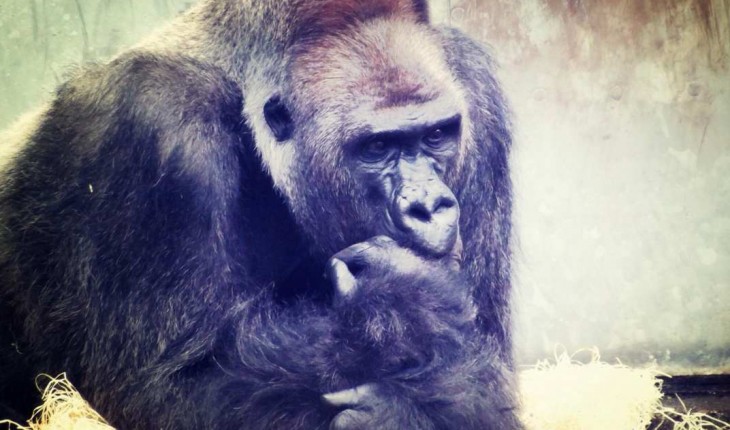Dogs can read human emotions. So, it appears, can horses. Whales have regional accents. Ravens have demonstrated that they might be able to guess at the thoughts of other ravens — something scientists call “theory of mind,” which has long been considered a uniquely human ability. All of these findings have been published within the past several weeks, and taken together they suggest that many of the traits and abilities we believe are “uniquely human” are, in fact, not so unique to us.
That statement probably sounds as if it is veering perilously close to anthropomorphism, and if you know anything about research concerning animal behavior, you likely know this: Anthropomorphism is bad. Animals are animals, and people are people; to assume that an elephant, for example, experiences joy in the same way a human does is laughably unscientific. This has been the prevailing mode of thought in this line of scientific inquiry for most of the last century — to staunchly avoid, and even ridicule, any research project that dared to suggest that animals might be thinking or feeling in the same way that humans do.
But new studies like these, along with a slew of recent books by respected biologists and science writers, are seriously considering the inner lives of animals. Now some prominent scientists are arguing that, though the impulse was well-intentioned, decades of knee-jerk avoidance of all things anthropomorphic may have mostly served to hold this field back. “It ruined the field,” biologist and author Carl Safina told Science of Us. “Not just held it back — it’s ruined the field. It prevented people from even asking those questions for about 40 years.”
The theme of Safina’s book Beyond Words: What Animals Think and Feel pairs nicely with a forthcoming title from famed primatologist Frans de Waal called Are We Smart Enough to Know How Smart Animals Are? Both scientists make the case for something the biologist Gordon Burghardt called “critical anthropomorphism” — using your own human intuition and understanding as a starting point for understanding animal cognition. “Thus, saying that animals ‘plan’ for the future or ‘reconcile’ after fights is more than anthropomorphic language: These terms propose testable ideas,” de Waal writes.
Animal behavioral science began in the 1910s and 1920s by focusing on description in order to combat superstition (cats are not witches’ familiars, tortoises are not especially tenacious, and grasshoppers are not lazy, etc). The problem is that, eventually, “[d]escription — and only description — became ‘the’ science of animal behavior,” Safina writes in his book, which was published last summer. “Wondering what feelings or thoughts might motivate behavioral acts became totally taboo.” Here’s an example Safina uses: A “good” scientist’s notes might say something like, “The elephant positioned herself between her calf and the hyena.” A bad, anthropomorphic-leaning scientist, on the other hand, would observe the same scene and write, “The mother positioned herself to protect her baby from the hyena.” How can the scientist prove what the mother elephant was intending to do? You can’t see a thought; you can’t observe a feeling. Therefore, to presume that animals possessed either of these things was considered unscientific.
Even raising the mere question of animal awareness was once enough to potentially ruin a career. In the 1970s, the biologist Donald Griffin published a book that did almost exactly that: Question of Animal Awareness. Griffin at this point was a well-respected scientist who had recently made the discovery that bats use echolocation, or sonar, to navigate their surroundings. But after the publication of his book, his professional reputation was largely ruined. Even Jane Goodall caught some flak for going so far as to “humanize” her chimp research subjects by giving them names, and as recently as the 1990s, a writer in the prestigious journal Science advised that research concerning animal cognition “isn’t a project I’d recommend to anyone without tenure.”
Better data, including advances in neuroimaging technology and videos from scientists doing fieldwork, is now forcing many to reconsider some very basic questions of animal cognition. Today it sometimes seems like barely a week goes by without the publication of some new study that shows evidence of one species or another demonstrating what might’ve once been considered a strictly “human” ability or emotion.
Evidence of empathy, and even comforting behavior, has been observed in a variety of species. A recent study proposed that the humble prairie vole, a rodent found across the United States and Canada, appears to console its fellow vole after mean scientists stress it out by giving it a (small) electric shock.
Behaviors that look a lot like consolation have also been observed in animals known for their sociability, like elephants. When one Asian elephant sees that another elephant is agitated, scientists have observed that the calmer one will respond by touching the distressed animal with its trunk. “I’ve never heard that vocalization when elephants are alone,” Joshua Plotnik, who led the study, told Discovery. “It may be a signal like, ‘Shshh, it’s okay,’ the sort of sounds a human adult might make to reassure a baby.”
Contagious yawning, some scientists argue, is another signal of empathy and has recently been observed and recorded in chimpanzees.
Some research suggests that a few animals have demonstrated signals of self-awareness. The best way scientists currently have of measuring this admittedly abstract concept is the mirror recognition test (though some recent work has called the accuracy of this method into question). This usually involves marking the subject with some kind of conspicuous, but odorless, dye and placing it in front of a mirror. Passing the test involves examining the mark in the mirror, and then examining it on their own body; this suggests that the animal grasps that the reflection is a representation of them. Apes and monkeys seem to be able to figure the game out.
In the early 2000s, a pair of scientists found that bottlenose dolphins could also pass the mirror test with flying colors. In her new book Voices in the Ocean, science writer Susan Casey nods to that study, and notes that, in subsequent years, elephants and magpies have also taken the mirror test and passed. (For context, humans don’t pass this test until they are about 2.)
Some animals appear to be capable of understanding the perspective of others. Beyond the raven’s newly discovered behaviors, there is evidence that scrub jays are able to see the world from another scrub jay’s viewpoint, which helps them hide their food. Male Eurasian jays seem to be able to make a good guess at what sort of food female Eurasian jays might like to eat. “It was long thought that only humans could do this,” University of Cambridge psychologist Nicola Clayton told Wired of the jay research. “What we’ve shown in a series of experiments is that doesn’t seem to be the case.”
To be sure, in an era of viral videos, it’s easy to take this idea — Anthropomorphism is okay now! — and get carried away with it. A perfect recent example is a back-and-forth over a picture of a trio of kangaroos. According to the Facebook caption accompanying the photo, the female had recently died, and the male and baby were “mourning” it. Media outlets took this at face value and ran with it, with headlines like “Dying Kangaroo Mom Spends Last Moment Holding Her Baby.”
And then, as is the circle of life for a viral news story, came the debunkings: The male kangaroo was just trying to have sex with the female, these articles scolded, and to believe any differently was a sign of “naive anthropomorphism.” Safina’s impression of the photo, incidentally, is that there really isn’t much we can tell one way or the other from a still photo. Really, the photo — or, more specifically, the instantly polarized online reactions to the photo — tell us more about ourselves than they do about kangaroo behavior.
“The one thing that is almost never allowed, or never thought of, is that there can be nuance,” Safina said. “There can be a range of emotions that happen in nonhumans, just as there is in humans.” After a human death, for example, the person’s loved ones show a range of emotions — denial, confusion, even some terribly inappropriate laughter. “But with animals everything has to be either/or,” Safina continued. People either want to believe that animals are pure and kindhearted and all-around better than we are — or they want to believe the very opposite, that humans are the most remarkable creatures on Earth, and animal behavior is driven only by instinct. (As if human behavior isn’t, too.)
Rushing to an unsupported conclusion that animals are just like us is bad, biased science. But willfully ignoring evidence of animal behaviors that look suspiciously like human emotions is unscientific and biased, too. “The key point is that anthropomorphism is not always as problematic as people think,” de Waal writes, adding that this is probably particularly true of animals with brains like ours: apes, sure, but even elephants and some marine mammals like dolphins. After all, we’re animals, too.




